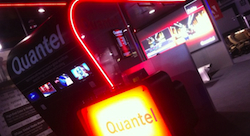
On the eve of NAB 2012 Quantel launched a new concept in content management which might actually merit this year’s buzzword “game-changing”, writes Dick Hobbs.
RevolutionQ aims to remove all the challenges of storing video, audio and metadata through the use of vast amounts of low cost commodity hardware. The Quantel product is a new software architecture that manages huge amount of COTS (commodity of the shelf) disk drives, potentially in multiple locations, in a service-oriented architecture. The first purchaser of RevolutionQ, identified only as a large US broadcaster, is building a system of many petabytes in an investment of more than $10 million.
Explaining the transformational nature of the product, Quantel’s Steve Owen said that at today’s prices you can buy two petabytes – million gigabytes – of COTS disk drives for around a million dollars. Two petabytes is the equivalent of 90,000 hours of video at 50Mb/s: more than 10 years of content, and of course the cost of storage continues to fall. “You no longer need a hierarchical storage management system, you never need to think about partial restore from archive – everything is online,” Owen said. “The ingest is the online store is the archive.”
The reason this has not been done before, and why Quantel is so proud of this achievement, is that managing this vast amount of data is a hugely complex task. Central to the success of RevolutionQ will be the Quantel Virtual File System (QVFS), which is based on MXF AS-02 bundles. It is this which allows effectively infinite numbers of media assets to be online, and delivered to any user with a latency measured in seconds. The file system uses schema-free metadata, which means any third-party application can be attached to it, just picking the metadata it needs. Content can be researched using simple web services tools, so it is very fast to learn. More important, having all media assets in a single physical and logical system means that users – editors and producers – need to look in just one place for all the content available, and have it delivered to their desktop or workstation instantly rather than waiting for archive retrieval. SL2415






